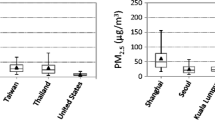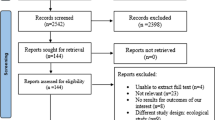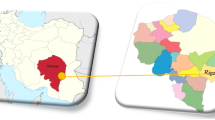Abstract
In recent decades, particulate matter (PM) concentrations in Tehran have exceeded the World Health Organization’s (WHO) guideline on most days. In this study, a search protocol was defined by identifying the keywords, to carry out a systematic review of the concentrations and composition of PM in Tehran’s ambient air. For this purpose, searches were done in Scopus, PubMed, and Web of Science in 2019. Among the founded articles (197 in Scopus, 61 in PubMed, and 153 in Web of Science). The results show that in Tehran, the annual average PM10 exceeded the WHO guidelines and for more than 50.0% of the days, the PM2.5 concentration was more than WHO 24-h guidance value. The PM concentration in Tehran has two seasonal peaks due to poorer dispersion and suspension from dry land, respectively. Tehran has two daily PM peaks due to traffic and changes in boundary-layer heights; one just after midnight and the other during morning rush hour. Indoor concentrations of PM10 and PM2.5 in Tehran were 10.6 and 21.8 times higher than the corresponding values in ambient air. Tehran represents a unique case of problems of controlling PM because of its geographical setting, emission sources, and land use. This review provided a comprehensive assessment for decision makers to assist them in making appropriate policy decisions to improve the air quality. Considering factors such as diversity of resources, temporal and spatial variations, and urban location is essential in developing control plans. Also future studies should focus more on PM reduction plans.



Similar content being viewed by others
References
Arhami M, Shahne MZ, Hosseini V, Haghighat NR, Lai AM, Schauer JJ. Seasonal trends in the composition and sources of PM2. 5 and carbonaceous aerosol in Tehran, Iran. Environmental pollution. 2018;239:69–81.
Arhami M, Hosseini V, Shahne MZ, Bigdeli M, Lai A, Schauer JJ. Seasonal trends, chemical speciation and source apportionment of fine PM in Tehran. Atmos Environ. 2017;153:70–82.
Faridi S, Shamsipour M, Krzyzanowski M, Künzli N, Amini H, Azimi F, et al. Long-term trends and health impact of PM2. 5 and O3 in Tehran, Iran, 2006–2015. Environment international. 2018;114:37–49.
Hajiloo F, Hamzeh S, Gheysari M. Impact assessment of meteorological and environmental parameters on PM 2.5 concentrations using remote sensing data and GWR analysis (case study of Tehran). Environ Sci Pollut Res, 2018:1–15.
Shahbazi H, Hassani A, Hosseini V. Evaluation of Tehran clean air action plan using emission inventory approach. Urban Clim. 2019;27:446–56.
Amini H, Taghavi-Shahri SM, Henderson SB, Naddafi K, Nabizadeh R, Yunesian M. Land use regression models to estimate the annual and seasonal spatial variability of sulfur dioxide and particulate matter in Tehran, Iran. Sci Total Environ. 2014;488:343–53.
Alizadeh-Choobari O, Bidokhti A, Ghafarian P, Najafi M. Temporal and spatial variations of particulate matter and gaseous pollutants in the urban area of Tehran. Atmos Environ. 2016;141:443–53.
Croft DP, Zhang W, Lin S, Thurston SW, Hopke PK, van Wijngaarden E, Squizzato S, Masiol M, Utell MJ, Rich DQ. Associations between source-specific particulate matter and respiratory infections in New York state adults. Environ Sci Technol. 2019.
Hopke PK, Croft D, Zhang W, Lin S, Masiol M, Squizzato S, et al. Changes in the acute response of respiratory diseases to PM2. 5 in New York state from 2005 to 2016. Sci Total Environ. 2019;677:328–39.
Zhang W, Lin S, Hopke PK, Thurston SW, van Wijngaarden E, Croft D, et al. Triggering of cardiovascular hospital admissions by fine particle concentrations in New York state: before, during, and after implementation of multiple environmental policies and a recession. Environ Pollut. 2018;242:1404–16.
Nabizadeh R, Yousefi M, Azimi F. Study of particle number size distributions at Azadi terminal in Tehran, comparing high-traffic and no traffic area. MethodsX. 2018;5:1549–55.
Chen G, Li S, Zhang Y, Zhang W, Li D, Wei X, et al. Effects of ambient PM1 air pollution on daily emergency hospital visits in China: an epidemiological study. Lancet Planet Health. 2017;1:e221–9.
Croft DP, Zhang W, Lin S, Thurston SW, Hopke PK, Masiol M, et al. The association between respiratory infection and air pollution in the setting of air quality policy and economic change. Annals Am Thoracic Soc. 2019;16:321–30.
Hassanvand MS, Naddafi K, Faridi S, Arhami M, Nabizadeh R, Sowlat MH, et al. Indoor/outdoor relationships of PM10, PM2. 5, and PM1 mass concentrations and their water-soluble ions in a retirement home and a school dormitory. Atmospheric Environment. 2014;82:375–82.
Hopke PK, Croft DP, Zhang W, Lin S, Masiol M, Squizzato S, et al. Changes in the hospitalization and ED visit rates for respiratory diseases associated with source-specific PM2. 5 in New York State from 2005 to 2016. Environ Res. 2020;181:108912.
Rich DQ, Zhang W, Lin S, Squizzato S, Thurston SW, van Wijngaarden E, et al. Triggering of cardiovascular hospital admissions by source specific fine particle concentrations in urban centers of New York state. Environ Int. 2019;126:387–94.
Stanaway JD, Afshin A, Gakidou E, Lim SS, Abate D, et al. Murray, Global, regional, and national comparative risk assessment of 84 behavioural, environmental and occupational, and metabolic risks or clusters of risks for 195 countries and territories, 1990–2017: a systematic analysis for the Global Burden of Disease Study 2017. Lancet. 2018;392:1923–94.
Delbari AS, Hadavifar M, Haghparast H. Concentration and characterization of airborne particles in two subway systems of Islamic Republic of Iran and India. J Air Pollut Health. 2016;1:61–8.
Halek F, Kianpour-Rad M, Kavousirahim A. Parametric evaluation of indoor particulate matters in elementary schools in the central parts of Tehran. Indoor Built Environ. 2013;22:580–5.
Heydari G, Taghizdeh F, Fazlzadeh M, Jafari AJ, Asadgol Z, Mehrizi EA, et al. Levels and health risk assessments of particulate matters (PM 2.5 and PM 10) in indoor/outdoor air of waterpipe cafés in Tehran, Iran. Environ Sci Pollut Res. 2019;26:7205–15.
Kord Mostafapour F, Jaafari J, Gharibi H, Sepand MR, Hoseini M, Balarak D, et al. Characterizing of fine particulate matter (PM1) on the platforms and outdoor areas of underground and surface subway stations. Human Ecol Risk Assessment: Int J. 2018;24:1016–29.
Bolourchi A, Atabi F, Moattar F, Ehyaei M. Experimental and numerical analyses of particulate matter concentrations in underground subway station. Int J Environ Sci Technol. 2018;15:2569–80.
Halek F, Keyanpour-rad M, Kavousi A. Dependency of polycyclic aromatic hydrocarbon concentrations on particle size distribution in Tehran atmosphere. Toxicol Environ Chem. 2010;92:841–53.
Halek F, Kianpour-Rad M, Kavousirahim A. Seasonal variation in ambient PM mass and number concentrations (case study: Tehran, Iran). Environ Monit Assess. 2010;169:501–7.
Esmaili N, Khashman S, Lamehi-Rachti M, Aligol DA, Shokouhi F, Oliaiy P, et al. Elemental analysis of aerosols in Tehran’s atmosphere using PIXE and identification of pollution sources. Environ Monit Assess. 2014;186:7505–12.
Faraji M, Pourpak Z, Naddafi K, Nodehi RN, Nicknam MH, Shamsipour M, et al. Effects of airborne particulate matter (PM10) from dust storm and thermal inversion on global DNA methylation in human peripheral blood mononuclear cells (PBMCs) in vitro. Atmos Environ. 2018;195:170–8.
Shirazi M, Harding A. Ambient air quality levels in Tehran, Iran, from 1988 to 1993. Int J Environ Pollut. 2001;15:517–27.
Naddafi K, Sowlat M, Safari M. Integrated assessment of air pollution in Tehran, over the period from September 2008 to September 2009. Iran J Public Health. 2012;41:77.
Kakooei H, Kakooei AA. Measurement of PM10, PM25 and TSP particle concentrations in Tehran, Iran. J Appl Sci. 2007;7:3081–5.
Arhami M, Kamali N, Rajabi MM. Predicting hourly air pollutant levels using artificial neural networks coupled with uncertainty analysis by Monte Carlo simulations. Environ Sci Pollut Res. 2013;20:4777–89.
Shahbazi H, Taghvaee S, Hosseini V, Afshin H. A GIS based emission inventory development for Tehran. Urban Clim. 2016;17:216–29.
Yazdi MN, Delavarrafiee M, Arhami M. Evaluating near highway air pollutant levels and estimating emission factors: case study of Tehran, Iran. Sci Total Environ. 2015;538:375–84.
Yazdi MN, Arhami M, Delavarrafiee M, Ketabchy M. Developing air exchange rate models by evaluating vehicle in-cabin air pollutant exposures in a highway and tunnel setting: case study of Tehran, Iran. Environ Sci Pollut Res. 2019;26:501–13.
Jaafari J, Naddafi K, Yunesian M, Nabizadeh R, Hassanvand MS, Ghozikali MG, et al. Study of PM10, PM2. 5, and PM1 levels in during dust storms and local air pollution events in urban and rural sites in Tehran. Human Ecol Risk Assess: An Int J. 2018;24:482–93.
Halek F, Kavousi-Rahim A. GIS assessment of the PM 10, PM 2.5 and PM 1.0 concentrations in urban area of Tehran in warm and cold seasons, The International Archives of Photogrammetry. Remote Sensing and Spatial Information Sciences. 2014;40:141.
Atafar Z, Pourpak Z, Yunesian M, Nicknam MH, Hassanvand MS, Soleimanifar N, et al. Proinflammatory effects of dust storm and thermal inversion particulate matter (PM 10) on human peripheral blood mononuclear cells (PBMCs) in vitro: a comparative approach and analysis. J Environ Health Sci Eng. 2019;17:433–44.
Gillette DA, Blifford IH Jr, Fryrear D. The influence of wind velocity on the size distributions of aerosols generated by the wind erosion of soils. J Geophys Res. 1974;79:4068–75.
Gillette DA, Stensland GJ, Williams AL, Barnard W, Gatz D, Sinclair PC, et al. Emissions of alkaline elements calcium, magnesium, potassium, and sodium from open sources in the contiguous United States. Glob Biogeochem Cycles. 1992;6:437–57.
Leili M, Naddafi K, Nabizadeh R, Yunesian M, Mesdaghinia A. The study of TSP and PM 10 concentration and their heavy metal content in central area of Tehran, Iran. Air Quality Atmosphere Health. 2008;1:159–66.
Sowlat MH, Gharibi H, Yunesian M, Mahmoudi MT, Lotfi S. A novel, fuzzy-based air quality index (FAQI) for air quality assessment. Atmos Environ. 2011;45:2050–9.
Kermani M, Dowlati M, Jonidi Jafari A, Rezaei Kalantari R. Health impact caused by exposure to particulate matter in the air of Tehran in the past decade. Tehran Univ Med J TUMS Publ. 2017;74:885–92.
Halek F, Kavouci A, Montehaie H. Role of motor-vehicles and trend of air borne particulate in the great Tehran area, Iran. Int J Environ Health Res. 2004;14:307–13.
Sohrabpour M, Mirzaee H, Rostami S, Athari M. Elemental concentration of the suspended particulate matter in the air of Tehran. Environ Int. 1999;25:75–81.
Hoseini M, Yunesian M, Nabizadeh R, Yaghmaeian K, Ahmadkhaniha R, Rastkari N, et al. Characterization and risk assessment of polycyclic aromatic hydrocarbons (PAHs) in urban atmospheric particulate of Tehran, Iran. Environ Sci Pollut Res. 2016;23:1820–32.
Hassanvand MS, Naddafi K, Faridi S, Nabizadeh R, Sowlat MH, Momeniha F, et al. Characterization of PAHs and metals in indoor/outdoor PM10/PM2. 5/PM1 in a retirement home and a school dormitory. Sci Total Environ. 2015;527:100–10.
MohseniBandpi A, Eslami A, Shahsavani A, Khodagholi F, Alinejad A. Physicochemical characterization of ambient PM2. 5 in Tehran air and its potential cytotoxicity in human lung epithelial cells (A549). Sci Total Environ. 2017;593:182–90.
Mohseni Bandpi A, Eslami A, Shahsavani A, Khodagholi F, Aliaghaei A, Alinejad A. Water-soluble and organic extracts of ambient PM2. 5 in Tehran air: assessment of genotoxic effects on human lung epithelial cells (A549) by the comet assay. Toxin Rev. 2017;36:116–24.
Kamani H, Hoseini M, Seyedsalehi M, Mahdavi Y, Jaafari J, Safari GH. Concentration and characterization of airborne particles in Tehran’s subway system. Environ Sci Pollut Res. 2014;21:7319–28.
Cordtz R, Schramm J, Rabe R. Investigating SO3 formation from the combustion of heavy fuel oil in a four-stroke medium-speed test engine. Energy Fuel. 2013;27:6279–86.
Rezaei S, Naddafi K, Hassanvand MS, Nabizadeh R, Yunesian M, Ghanbarian M, et al. Physiochemical characteristics and oxidative potential of ambient air particulate matter (PM 10) during dust and non-dust storm events: a case study in Tehran, Iran. J Environ Health Sci Eng. 2018;16:147.
Kholdebarin A, Biati A, Moattar F, Shariat SM. Outdoor PM 10 source apportionment in metropolitan cities—a case study. Environ Monit Assess. 2015;187:49.
Taghvaee S, Sowlat MH, Mousavi A, Hassanvand MS, Yunesian M, Naddafi K, et al. Source apportionment of ambient PM2. 5 in two locations in Central Tehran using the positive matrix factorization (PMF) model. Sci Total Environ. 2018;628:672–86.
Halek F, Keyanpour-Rad M, Darbani RM, Kavousirahim A. Concentrations and source assessment of some atmospheric trace elements in northwestern region of Tehran, Iran. Bull Environ Contamination Toxicol. 2010;84:185–90.
Motesaddi Zarandi S, Raei Shaktaie H, Yazdani Cheratee J, Hosseinzade F, Dowlati M. Evaluation of PM2. 5 concentration and determinant parameters on its distribution in Tehran’s metro system in 2012. J Mazandaran Univ Med Sci. 2013;22:37–46.
Faraji M, Pourpak Z, Naddafi K, Nodehi RN, Nicknam MH, Shamsipour M, et al. Chemical composition of PM 10 and its effect on in vitro hemolysis of human red blood cells (RBCs): a comparison study during dust storm and inversion. J Environ Health Sci Eng. 2019;17:493.
Akbarzadeh MA, Khaheshi I, Sharifi A, Yousefi N, Naderian M, Namazi MH, et al. The association between exposure to air pollutants including PM10, PM2. 5, ozone, carbon monoxide, sulfur dioxide, and nitrogen dioxide concentration and the relative risk of developing STEMI: a case-crossover design. Environ Res. 2018;161:299–303.
Bayat R, Ashrafi K, Motlagh MS, Hassanvand MS, Daroudi R, Fink G, Künzli N. Health impact and related cost of ambient air pollution in Tehran. Environ Res. 2019 108547.
Ansari M, Ehrampoush MH. Meteorological correlates and AirQ+ health risk assessment of ambient fine particulate matter in Tehran, Iran. Environ Res. 2019;170:141–50.
Hadei M, Nazari SSH, Yarahmadi M, Kermani M, Farhadi M, Shahsavani A. Estimation of gender-specific lung cancer deaths due to exposure to PM2. 5 in 10 cities of Iran during 2013–2016: A modeling approach, cities, 2016. 2013.
Marzouni MB, Moradi M, Zarasvandi A, Akbaripoor S, Hassanvand MS, Neisi A, et al. Health benefits of PM 10 reduction in Iran. Int J Biometeorol. 2017;61:1389–401.
Naddafi K, Hassanvand MS, Yunesian M, Momeniha F, Nabizadeh R, Faridi S, et al. Health impact assessment of air pollution in megacity of Tehran, Iran. Iranian J Environ Health Sci Eng. 2012;9:28.
Mehrpour M, Shams-Hosseini NS, Rezaali S, Sahraiian MA, Taki S. Effect of air pollutant markers on multiple sclerosis relapses. Iran J Public Health. 2013;42:1167.
Dehghani MH, Jarahzadeh S, Hadei M, Mansouri N, Rashidi Y, Yousefi M. The data on the dispersion modeling of traffic-related PM10 and CO emissions using CALINE3, A case study in Tehran, Iran. Data Brief. 2018;19:2284–90.
Taghvaee S, Sowlat MH, Hassanvand MS, Yunesian M, Naddafi K, Sioutas C. Source-specific lung cancer risk assessment of ambient PM2. 5-bound polycyclic aromatic hydrocarbons (PAHs) in Central Tehran. Environ Int. 2018;120:321–32.
Acknowledgments
The authors gratefully acknowledge the financial support given by the Research Center for Environmental Health Technology, Iran University of Medical Sciences, Tehran, Iran (Grant Number: 98-4-61-16815).
Funding
This study was funded by Iran University of Medical Sciences (Grant Number: 98–4–61-16815).
Author information
Authors and Affiliations
Corresponding author
Ethics declarations
Declarations of interest
None.
Additional information
Publisher’s note
Springer Nature remains neutral with regard to jurisdictional claims in published maps and institutional affiliations.
Rights and permissions
About this article
Cite this article
Torkashvand, J., Jafari, A.J., Hopke, P.K. et al. Airborne particulate matter in Tehran’s ambient air. J Environ Health Sci Engineer 19, 1179–1191 (2021). https://doi.org/10.1007/s40201-020-00573-x
Received:
Accepted:
Published:
Issue Date:
DOI: https://doi.org/10.1007/s40201-020-00573-x




